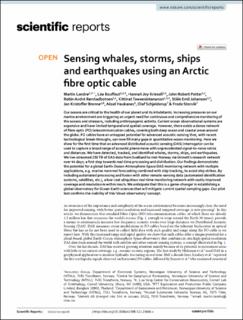| dc.contributor.author | Landrø, Martin | |
| dc.contributor.author | Bouffaut, Léa | |
| dc.contributor.author | Kriesell, Hannah Joy | |
| dc.contributor.author | Potter, John | |
| dc.contributor.author | Rørstadbotnen, Robin André | |
| dc.contributor.author | Taweesintananon, Kittinat | |
| dc.contributor.author | Johansen, Ståle Emil | |
| dc.contributor.author | Brenne, Jan Kristoffer | |
| dc.contributor.author | Haukanes, Aksel | |
| dc.contributor.author | Schjelderup, Olaf | |
| dc.contributor.author | Storvik, Frode | |
| dc.date.accessioned | 2023-01-19T13:56:19Z | |
| dc.date.available | 2023-01-19T13:56:19Z | |
| dc.date.created | 2022-11-11T16:14:02Z | |
| dc.date.issued | 2022 | |
| dc.identifier.citation | Scientific Reports. 2022, 12 . | en_US |
| dc.identifier.issn | 2045-2322 | |
| dc.identifier.uri | https://hdl.handle.net/11250/3044696 | |
| dc.description.abstract | Our oceans are critical to the health of our planet and its inhabitants. Increasing pressures on our marine environment are triggering an urgent need for continuous and comprehensive monitoring of the oceans and stressors, including anthropogenic activity. Current ocean observational systems are expensive and have limited temporal and spatial coverage. However, there exists a dense network of fibre-optic (FO) telecommunication cables, covering both deep ocean and coastal areas around the globe. FO cables have an untapped potential for advanced acoustic sensing that, with recent technological break-throughs, can now fill many gaps in quantitative ocean monitoring. Here we show for the first time that an advanced distributed acoustic sensing (DAS) interrogator can be used to capture a broad range of acoustic phenomena with unprecedented signal-to-noise ratios and distances. We have detected, tracked, and identified whales, storms, ships, and earthquakes. We live-streamed 250 TB of DAS data from Svalbard to mid-Norway via Uninett’s research network over 44 days; a first step towards real-time processing and distribution. Our findings demonstrate the potential for a global Earth-Ocean-Atmosphere-Space DAS monitoring network with multiple applications, e.g. marine mammal forecasting combined with ship tracking, to avoid ship strikes. By including automated processing and fusion with other remote-sensing data (automated identification systems, satellites, etc.), a low-cost ubiquitous real-time monitoring network with vastly improved coverage and resolution is within reach. We anticipate that this is a game-changer in establishing a global observatory for Ocean-Earth sciences that will mitigate current spatial sampling gaps. Our pilot test confirms the viability of this ‘cloud-observatory’ concept. | en_US |
| dc.description.abstract | Sensing whales, storms, ships and earthquakes using an Arctic fibre optic cable | en_US |
| dc.language.iso | eng | en_US |
| dc.publisher | Nature Research | en_US |
| dc.rights | Navngivelse 4.0 Internasjonal | * |
| dc.rights.uri | http://creativecommons.org/licenses/by/4.0/deed.no | * |
| dc.subject | Fibre optic sensors | en_US |
| dc.subject | Fibre optic sensors | en_US |
| dc.title | Sensing whales, storms, ships and earthquakes using an Arctic fibre optic cable | en_US |
| dc.title.alternative | Sensing whales, storms, ships and earthquakes using an Arctic fibre optic cable | en_US |
| dc.type | Peer reviewed | en_US |
| dc.type | Journal article | en_US |
| dc.description.version | publishedVersion | en_US |
| dc.subject.nsi | VDP::Oseanografi: 452 | en_US |
| dc.subject.nsi | VDP::Oceanography: 452 | en_US |
| dc.subject.nsi | VDP::Oseanografi: 452 | en_US |
| dc.subject.nsi | VDP::Oceanography: 452 | en_US |
| dc.subject.nsi | VDP::Oseanografi: 452 | en_US |
| dc.subject.nsi | VDP::Oceanography: 452 | en_US |
| dc.source.pagenumber | 10 | en_US |
| dc.source.volume | 12 | en_US |
| dc.source.journal | Scientific Reports | en_US |
| dc.identifier.doi | 10.1038/s41598-022-23606-x | |
| dc.identifier.cristin | 2072643 | |
| dc.relation.project | Norges forskningsråd: 294404 | en_US |
| dc.relation.project | Norges forskningsråd: 228107 | en_US |
| dc.relation.project | Norges forskningsråd: 309960 | en_US |
| cristin.ispublished | true | |
| cristin.fulltext | original | |
| cristin.qualitycode | 1 | |

